Best red wigglers: For sustainable composting
Obtain one of the most Out of Your Garden Compost With Red Wigglers
The integration of red wigglers right into your composting system can significantly boost the performance and performance of waste monitoring techniques. These worms are not only proficient at breaking down organic materials however likewise add to the creation of high-grade garden compost that improves dirt health and wellness. Understanding their ideal treatment demands and the benefits of vermicomposting is vital for making the most of outcomes (red wigglers). The process of establishing up and keeping a worm bin may offer challenges that warrant mindful consideration. Exploring the details of this approach can disclose remedies to usual composting concerns faced by numerous garden enthusiasts.
Comprehending Red Wigglers
Recognizing red wigglers is essential for anyone interested in vermicomposting, as these worms play a critical function in breaking down organic issue. Clinically referred to as Eisenia fetida, red wigglers are differentiated by their reddish-brown shade and slim bodies, generally gauging in between 3 to 4 inches in size. Unlike earthworms, which grow in dirt, red wigglers like a damp, organic-rich atmosphere, making them suitable for composting systems.
These worms are renowned for their starved hunger, eating half their body weight in natural product daily. This ability enables them to quickly break down kitchen scraps, lawn waste, and other biodegradable products, changing them into nutrient-rich garden compost. Red wigglers thrive in temperature levels ranging from 55 ° F to 77 ° F, demanding mindful tracking of their environment to ensure optimal task.
Additionally, red wigglers recreate swiftly, increasing their populace around every 3 to 4 weeks under excellent problems. This quick recreation is important for maintaining a reliable composting operation. red wigglers. Understanding their biology and behavior is essential for anyone wanting to harness their potential in sustainable waste monitoring practices
Benefits of Vermicomposting
Vermicomposting offers countless advantages that extend beyond straightforward waste reduction. This innovative approach leverages the all-natural decay capabilities of red wigglers to change natural waste right into nutrient-rich garden compost, improving soil health and wellness and fertility. The resulting vermicompost is including beneficial microbes, which can enhance soil structure and increase vitamins and mineral schedule for plants.

Furthermore, vermicomposting can be practiced in numerous settings, making it available for city occupants and those with restricted outside room. It needs very little investment and can be easily taken care of inside or outdoors, making it appropriate for numerous way of lives.
Making use of vermicompost additionally promotes healthier plant growth by improving microbial task, boosting water retention, and providing crucial nutrients. Gardeners and farmers who include vermicompost into their techniques typically observe increased crop yields, making vermicomposting a sustainable choice for both waste management and agricultural productivity.
Setting Up Your Worm Bin
Creating an efficient worm container is vital for successful vermicomposting, and with just a couple of essential parts, anybody can establish an effective system. Begin with an appropriate container; a plastic or wooden container with a lid works well. Ideally, the container ought to be in between 10 to 18 inches deep to offer adequate space for the worms to grow.
Guarantee correct ventilation by piercing little holes in the sides and lid, enabling airflow while maintaining dampness. Maintain a balance in between dampness and drainage; the bin must perspire yet not saturated. A layer of bed linen, such as shredded newspaper or cardboard, offers an environment for the worms and help in moisture retention.
Consider the area of your worm container (red wigglers). By complying with these guidelines, you will produce a helpful setting for red wigglers, laying the groundwork for an effective vermicomposting venture.
Feeding Your Red Wigglers

Avoid feeding them meat, dairy, and oily foods, as these can draw in pests and create undesirable smells. Furthermore, it is vital to slice or shred larger items to promote quicker decomposition, guaranteeing your worms can access the nutrients more effectively.
Moderation is vital; overfeeding can lead to anaerobic problems, hurting the worms and decreasing the composting procedure. Monitor the bin for uneaten food and adjust your feeding regime as necessary. A basic rule is to offer concerning half an extra pound of food per pound of worms each week.
Finally, keeping dampness is important. Go for a damp, however not soaked, setting, as moisture aids in the malfunction of food and sustains worm task. By thoroughly managing their diet regimen, you can boost the effectiveness of your red wigglers in transforming natural waste right into rich compost.
(redworms for composting)
Harvesting and Utilizing Compost
After a number of weeks of attentive composting, you will certainly observe that the rich, dark material produced by your red wigglers awaits harvest. This nutrient-dense worm spreadings, usually referred to as vermicompost, can significantly enhance soil health and wellness and plant growth. To collect, delicately different the completed compost from the staying bedding and worms. One efficient approach is to use a light; red wigglers are delicate to light and will tunnel deeper into the material, allowing you to dig the leading layer of garden compost.
When gathered, the compost can be utilized in numerous applications. Mix it right into garden soil to enhance structure and fertility, or utilize it as a leading clothing for potted plants. It can likewise be thinned down in water to develop a nutrient-rich fluid fertilizer, frequently called "worm tea." This tea can be helpful hints applied directly to plants, supplying them with a boost of necessary nutrients.
Remember to keep any kind of unused compost in a trendy, dry location to keep its quality. By successfully collecting and utilizing the compost generated by red wigglers, you not only enhance your yard but also promote lasting gardening practices.
Verdict
Incorporating red wigglers into composting techniques substantially enhances the performance of natural waste transformation. Ultimately, the combination of red wigglers in composting contributes to lasting horticulture, lowers garbage dump waste, and promotes ecological stewardship through reliable resource recycling.